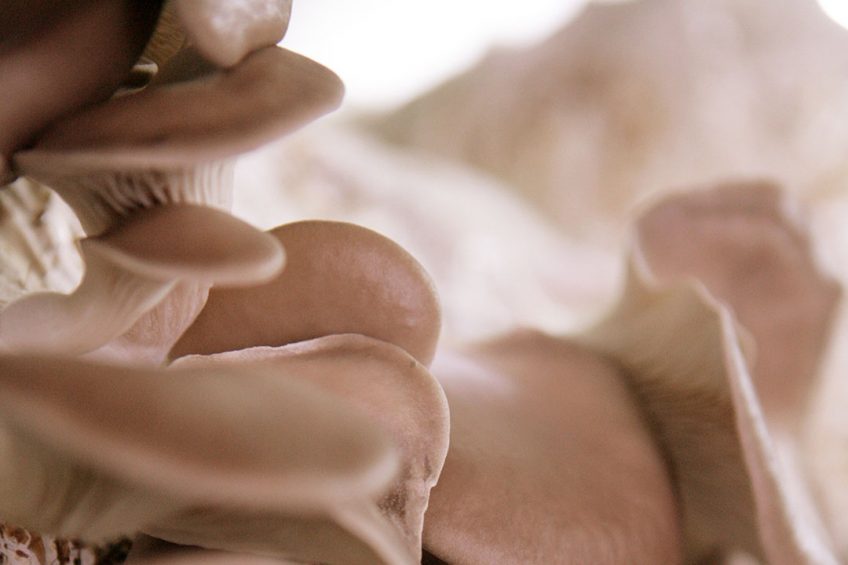Oyster mushrooms: A diarrhoea remedy for piglets

The feed industry is focusing on alternatives to reduce the use of antibiotics as growth promoters and zinc oxide as a diarrhoea remedy in piglet diets. Thanks to its immunomodulation properties, among other properties, oyster mushroom is one of the potential alternatives.
Zinc oxide (ZnO) is usually recommended for inclusion during the first 2 weeks after weaning to prevent post-weaning diarrhoea in pigs. However, due to its low absorption, most ZnO is excreted in faeces, which is detrimental to the environment. Whereas therapeutic ZnO is not approved for use in the EU as from 2022, antibiotics are an alternative to the control of Escherichia coli infections post-weaning.
 Weaning – special publication
Weaning – special publication
Weaning is a time of many changes for young piglets. Ensuring a smooth transitional period for the young animals ultimately leads to a greater lifetime performance. So what can be done to make weaning a smooth process?
However, these antibiotics are being banned due to their effects on antimicrobial resistance. In humans, several studies (involving animal models) have shown that edible mushrooms have immunomodulating properties, including β-glucan-induced anti-inflammatory effects, enhanced natural killer (NK) cell activity, improved dendritic cell maturation and function and increased cytokine production in patients with ulcerative colitis and Crohn’s disease. Mushrooms contain secondary metabolites such as alkaloids, lactones, polyphenols, sesquiterpenes, sterols, terpenoids, β-glucans and glycoproteins. These metabolites are responsible for immunomodulation and have anticholesterolemic, anticancer and antioxidant properties.
Diarrhoea incidence in weaner piglets
Researchers at Jilin Agricultural University, Changchun, China, found valuable effects of supplementing piglet diets with oyster mushrooms.
The mushrooms were included in 3 doses:
- 5g/kg,
- 10g/kg and
- 15g/kg.
A total of 100 crossbred (Duroc×Large White×Landrace) weaner piglets were used. The inclusion of mushroom at 5g/kg feed resulted in a 51% lower incidence of diarrhoea compared to the control group, and 15g/kg resulted in a 55% lower incidence of diarrhoea.
The researchers attributed the reduction to the presence of bioactive compounds such as glucans, alkaloids, phenols and other active ingredients that can reduce the enteric bacteria (coliform, E. coli, etc.) population and activities in the intestines of piglets. The prebiotic properties of this mushroom resulted in high production of short chain fatty acids (SCFAs) such as butyrate, propionate and acetate. The bacteriostatic properties of butyrate result in a better immune response and a healthier gut – contributing to a reduction in the incidence of diarrhoea.
 Gut Health – special publication
Gut Health – special publication
Managing gut health is very complex with many parameters to consider. Back in 2018 Pig Progress published this special issue covering including stress-related intestinal issues in weaning pigs.
Gut microflora
Their findings showed that supplementing the diet with oyster mushrooms increased intestinal microbial population and diversity. The most abundant microbes in the treated groups were the Bacteroidetes phylum (which mainly produces acetate and propionate) and the Firmicutes phylum (for butyrate production).
The high fibre content of mushrooms is less digestible in the upper gastrointestinal tract (GIT) as it lacks fibre-digesting enzymes. However, microbes in the large intestine can ferment these fibres to synthesise SCFAs such as acetate, butyrate and propionate. These SCFAs lower the hindgut pH, creating unfavourable conditions for most pathogenic bacteria – thus promoting gut health. Butyrate also serves as the main source of energy for colonocytes, helping with the maintenance of gut homeostasis and intestinal epithelial integrity; its bacteriostatic properties help improve the immune response. Their study has shown that oyster mushrooms act as a prebiotic that favourably affects the composition and function of the host intestinal microbiota with enrichment in carbohydrate metabolism and increased SCFA production, conferring more intestinal epithelial barrier protection. The butyrate levels increased with the increase in dietary mushroom levels. The highest total SCFA levels occurred at an inclusion level of 10g/kg (see Table 1).
Immunomodulation
The researchers focused on immunoglobulins and cytokines as they regulate the immune system. In this study, oyster mushrooms stimulated the production of cytokines (interleukin-2 and tumour necrosis factor-α) and immunoglobulins (IgA, IgG and IgM). Cytokines are involved in pro-inflammatory and immune function: the onset, activation and regulation of inflammation, innate and specific immune response and acute phase reactions.
Immunoglobulins are a critical part of the immune response as they specifically recognise and bind to antigens, such as bacteria or viruses, and help to destroy them. In previous studies, the secondary metabolites in mushrooms have been reported to have special properties: an immunomodulation effect and anticholesterolemic, antioxidant and neuroprotective effects.
 Piglet health – special publication
Piglet health – special publication
Minimising piglet mortality is key to successful pig production. Finding the balance between mortality and litter size is one of the major challenges explored here, alongside other innovations to support piglets through suckling and into weaning and beyond.
Digestibility and growth performance
During weaning and immediately after weaning, a piglet’s digestive tract is not well developed and hence the digestion of most feed ingredients is compromised. In the present study, the digestion of protein, fibre and gross energy were increased by the addition of mushroom (see Table 2). Researchers suggested that the improvement in microbial composition enhances the digestibility of crude fibre and provides energy through production of SCFAs.
Mushrooms have high fibre content and these dietary fibres may decrease intestinal transit time – thus promoting better nutrient digestibility. The inclusion of oyster mushrooms in the diet of piglets also increased feed intake and improved growth rate and feed-to-gain ratio. Better feed conversion and consequent growth rate were attributed to improved nutrient digestibility and gut health.
The potential of oyster mushrooms
Weaning is a challenge in the early life of piglets: it exposes piglets to several disorders such as diarrhoea, as well as impaired intestinal metabolism and immune functions – subsequently affecting growth performance.
This study found that the dietary inclusion of 5–15g/kg oyster mushrooms has the potential to reduce the incidence of diarrhoea and increase the overall performance of piglets. With the use of ZnO to prevent diarrhoea in piglets being discouraged in the wake of its hazardous effects on the environment, oyster mushrooms are one of the potential alternative solutions.











